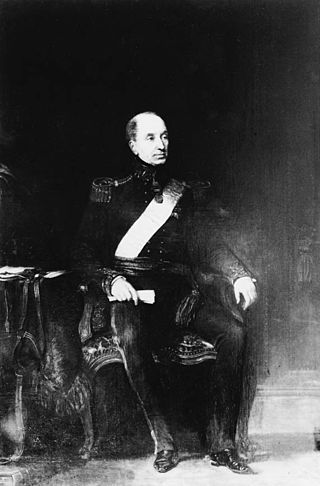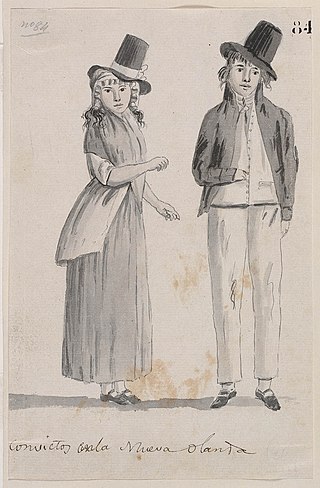| |||||
| Decades: | |||||
|---|---|---|---|---|---|
| See also: | |||||
The following lists events that happened during 1828 in Australia.
| |||||
| Decades: | |||||
|---|---|---|---|---|---|
| See also: | |||||
The following lists events that happened during 1828 in Australia.
Australia's first census was held in November 1828 in the colony of New South Wales. Previous government statistical reports had been taken from "musters" where inhabitants were brought together for counting. In 1828, the white population was 36,598 of whom 20,870 were free and 15,728 were convicts. 23.8% of the population were born in the colony. 24.5% were women. There were 25,248 Protestants and 11,236 Catholics. Indigenous Australians were not counted. [2]
Of the 36,598, 638 were living in what is now Queensland. There were also 18,128 people in Tasmania. [3]
This article describes the history of the Australian colony and state of Victoria.

Hamilton Hume was an early explorer of the present-day Australian states of New South Wales and Victoria. In 1824, along with William Hovell, Hume participated in an expedition that first took an overland route from Sydney to Port Phillip. Along with Sturt in 1828, he was part of an expedition of the first Europeans to find the Darling River.

Charles Napier Sturt was a British officer and explorer of Australia, and part of the European exploration of Australia. He led several expeditions into the interior of the continent, starting from Sydney and later from Adelaide. His expeditions traced several of the westward-flowing rivers, establishing that they all merged into the Murray River, which flows into the Southern Ocean. He was searching to prove his own passionately held belief that an "inland sea" was located at the centre of the continent. He reached the rank of Captain, served in several appointed posts, and on the Legislative Council.

The Macquarie River or Wambuul is part of the Macquarie–Barwon catchment within the Murray–Darling basin, is one of the main inland rivers in New South Wales, Australia.

The Colony of New South Wales was a colony of the British Empire from 1788 to 1901, when it became a State of the Commonwealth of Australia. At its greatest extent, the colony of New South Wales included the present-day Australian states of New South Wales, Queensland, Victoria, Tasmania, and South Australia, the Northern Territory as well as New Zealand. The first "responsible" self-government of New South Wales was formed on 6 June 1856 with Sir Stuart Alexander Donaldson appointed by Governor Sir William Denison as its first Colonial Secretary.

General Sir Ralph Darling, GCH was a British Army officer who served as Governor of New South Wales from 1825 to 1831. He is popularly described as a tyrant, accused of torturing prisoners and banning theatrical entertainment. Local geographical features named after him include the Darling River and Darling Harbour in Sydney.
The history of Australia from 1788 to 1850 covers the early British colonial period of Australia's history. This started with the arrival in 1788 of the First Fleet of British ships at Port Jackson on the lands of the Eora, and the establishment of the penal colony of New South Wales as part of the British Empire. It further covers the European scientific exploration of the continent and the establishment of the other Australian colonies that make up the modern states of Australia.
The history of New South Wales refers to the history of the Australian state of New South Wales and the area's preceding Indigenous and British colonial societies. The Mungo Lake remains indicate occupation of parts of the New South Wales area by Indigenous Australians for at least 40,000 years. The British navigator James Cook became the first European to map the coast in 1770 and a First Fleet of British convicts followed to establish a penal colony at Sydney in 1788.
The history of South Australia includes the history of the Australian state of South Australia since Federation in 1901, and the area's preceding Indigenous and British colonial societies. Aboriginal Australians of various nations or tribes have lived in South Australia for at least thirty thousand years, while British colonists arrived in the 19th century to establish a free colony. The South Australia Act, 1834 created the Province of South Australia, built according to the principles of systematic colonisation, with no convict settlers.
The following lists events that happened during 1829 in Australia.

Between 1788 and 1868, about 162,000 convicts were transported from Great Britain and Ireland to various penal colonies in Australia.
1851 in Australia was a watershed year. It saw the start of the Australian gold rushes with significant gold discoveries in both New South Wales in February and Victoria in July. As a result of the Gold Rushes, the European population of Victoria increased from 97,489 in 1851 to 538,628 in 1861 and the population of NSW increased from 197,265 in 1851 to 350,860 in 1861. Victoria became a self-governing colony. Sentiment in the eastern Australian colonies moved decisively against penal transportation leading to the end of transportation to Tasmania in 1853. Melbourne's major suburb/satellite city in the Dandenong Ranges, Belgrave was first settled, making it the oldest town in the Dandenong Ranges.
The following lists events that happened during 1881 in Australia.
The following lists events that happened during 1830 in Australia.
The following lists events that happened during 1831 in Australia.
The following lists events that happened during 1844 in Australia.
The following lists events that happened during 1845 in Australia.

European land exploration of Australia deals with the opening up of the interior of Australia to European settlement which occurred gradually throughout the colonial period, 1788–1900. A number of these explorers are very well known, such as Burke and Wills who are well known for their failed attempt to cross the interior of Australia, as well as Hamilton Hume and Charles Sturt.

The European exploration of Australia first began in February 1606, when Dutch navigator Willem Janszoon landed in Cape York Peninsula and on October that year when Spanish explorer Luís Vaz de Torres sailed through, and navigated, Torres Strait islands. Twenty-nine other Dutch navigators explored the western and southern coasts in the 17th century, and dubbed the continent New Holland.
The 1828 New South Wales census was the first population census held in the Crown Colony of New South Wales. The month used for the census, was taken in November 1828. The total population of the colony was counted as 36,598 and recorded all inhabitants, both convict and free. Only the European population were enumerated. Censuses were taken periodically in the colony thereafter.